President's Message
Happy Birthday, Henrico County! The festivities have already begun. On January 29, the Hunt for Henrico History was held at Deep Run Recreation Center, and it was a huge success. Hundreds of residents brought their artifacts and family history to be scanned and recorded. Experts were on hand to give advice on care of collections. A number of organizations, including HCHS, had information booths. Many thanks to Diane Brownie, Rick Pace, and John and Debbie Shuck for their help. The Boehling family (Joey, Cathy and Mary) assisted with collections and many other HCHS members attended. In case you missed it, there will be another Hunt for Henrico History held November 5th at Dorey Recreation Center.
While recently making copies of information on the Wackerly family of Highland Springs, I found a news article written in 1999 about Henricoan Harry Roberts, who served aboard the USS Henrico, soon after it was commissioned. You never know what you'll find when you go collecting. Treasure hunting is so much fun!
And speaking of Henricoans, as a project of the 2011 commemoration, the Henrico County Public Library Department is compiling a database on Notable Henricoans. To research the database or submit entries go to http://events.henricolibrary.org/nhdb/. A list of criteria for submitting a name is listed on the website.
Nine counties and part of a tenth were created from the original Henrico Shire as well as three cities. The historical societies of counties that were originally part of Henrico are sponsoring events in recognition of Henrico's 400th anniversary, and we're all invited! Be sure to mark the dates in your calendar for these events. HCHS will issue invitations to our sister societies to join us for our December 4th meeting for tea and festivities to celebrate our mutual birthday.
Henrico County now has an official song called "Echoes of Henrico." Lyrics were written by J.A. Parker, and it was commissioned for the 400th Anniversary. It was recently performed by a Henrico multi-school choral ensemble. Hearing it will make you proud to be a Henricoan.
Echoes of Henrico
We hear a distant echo...Of a song sung for our day!
It was sung by many voices...At a cost brave hearts will pay.
Their song was one of progress...Now they look to us and say...
Will you journey toward your future...In the same Henrico way?
History is a bridge across the centuries;
On one shore the dreams, on the other memories;
Bridge across time...Bridge across fire...
Bridge across water...Bridge across tears...
Bridge across wars...Bridge across trials...
Bridge across prejudice and fears
Let us join the distant echo...Of the song sung for our day!
We will join the many voices...In the cost brave hearts must pay!
Our song, like theirs, is progress...Let the future hear us say
We shall journey toward that future...In the same Henrico way!
Sarah Pace, President
>Back to Top<
Spring Demolition Planned: Glen Echo Building, a New Deal Project, to be Razed

As we plan celebrations of Henrico County's significant 400-year history, other plans are being made to raze a building that is a bit younger but also significant. Just east of the historic Dabbs House on Nine Mile Road, the 1938 Glen Echo School building, one of Roosevelt's New Deal projects, was one of two schools funded by Public Works Administration (PWA) built in Henrico County. The building, whose architecture reflects a Colonial Williamsburg influence, is scheduled to be torn down in late spring.
Glen Echo school opened in 1939 and operated until 1967, serving the orphaned children of the nearby Masonic Home of Virginia as well as other students in the area.
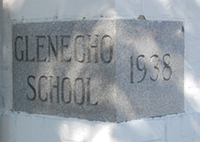
The building then became the meeting place for the Henrico County Board of Supervisors and all other governing bodies of the county and served as the temporary seat of Henrico County government for eight years (1966-1977).
The Glen Echo building continued to be used as a meeting place for the Henrico County School Board and currently houses the Public Health Department. To accommodate the Public Health Department, plans call for the demolition and replacement of this structure. The estimated cost to renovate this 14,000-square-foot building is $3.2 million. The estimated cost to replace Glen Echo with a building of comparable size is $7.2 million.
The origin, architecture and combined functions and uses of this building over the years make it a most unique public building. For these reasons, the Executive Board of the Henrico County Historical Society has passed a resolution requesting that the county reconsider its decision.
>Back to Top<
From the December HCHS Meeting

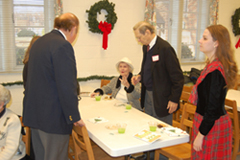
Ben Gregory addresses the members in attendance at December's quarterly meeting held at Calvary United Methodist Church on Williamsburg Road. After hearing about the church's history and its place in Richmond/Henrico history, members adjourned to the fellowship hall for refreshments.
>Back to Top<
Hunt for Henrico History
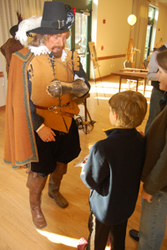

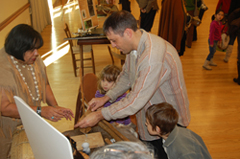
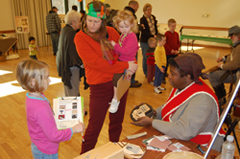

On Saturday, January 29, over 700 people visited the Deep Run Recreation Center for the first event commemorating the county's 400th anniversary. It will happen again on November 5 at Dorey Recreation Center.
>Back to Top<
Twelve Ways to Help Our Historical Society Grow in 2011
Over its 400 years of history, Henrico County has grown significantly. As we celebrate and commemorate, we would like for our historical society to experience significant growth as well. Everyone's help is needed and appreciated. Here are some ways you can help:
- Plan to attend all of our meetings this year. Our meeting dates are: March 6, June 5, September 11, and December 4.
- Invite at least one friend to attend each meeting with you. We welcome guests of all ages. If you know of someone who might enjoy a personal invitation, contact our corresponding secretary Lurline Wagner.
- Help publicize our meetings and special activities and fundraisers by sharing information with other community groups. If you belong to organizations that would be willing to post notices about our historical society in their own newsletters and websites and on bulletin boards in their facilities, our publicity chairman Mary Boehling would be happy to contact them with information.
- Purchase one more of our 2011 calendars to give as a gift. These calendars are keepsake editions and make wonderful gifts for all occasions. Some calendars already have made their way to distant states including Connecticut, Minnesota, and Texas as gifts to people who have ancestral ties to Henrico. You can purchase calendars at our next meeting or contact Sarah Pace to order one.
- Contact our vice-president Trevor Dickerson to make suggestions for programs you would like to see us feature at our quarterly meetings.
- Contact Joey Boehling to make suggestions for articles you would like to see included in future issues of the society newsletter.
- Contact our president Sarah Pace if you would like to join one of our special committees devoted to Henrico County cemteries, genealogy, and oral history or become a board member. Presently, we need someone to head our ways & means efforts.
- Make a tax-deductible donation to the Henrico County Historical Society. Because our non-profit organization depends on membership dues for operation, monetary donations are greatly appreciated at any time of the year. A list of donors will be included in our December newsletter. Contact our treasurer Debbie Shuck to make a donation.
- Help us locate local businesses who might be willing to purchase ads in society publications such as our magazine or make tax deductible donations to the Henrico County Historical Society. Contact Sarah Pace to make suggestions.
- Raise the level of your membership. Contact Debbie Shuck for information about the different levels.
- Give a gift membership in the Henrico County Historical Society to someone special. We welcome student members. Contact our treasurer Debbie Shuck.
- Remember someone dear to you with a tax-deductible memorial donation to the Henrico County Historical Society. Notice of memorial donations will be printed in our newsletter. Contact our treasurer Debbie Shuck to make a memorial donation.
Here are the contacts you'll want to contact:
>Back to Top<
News from the Cemetery Committee
Two year search ends in locating lost family gravesite!
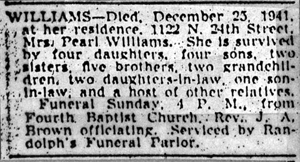
We volunteers have been working to reclaim Evergreen Cemetery from neglect and to find the grave of Pearl Williams, mother of HCHS member Welford Williams, for over two years. Mr. Williams has come to the cemetery several times to help us figure out the location of her grave, but with all of the brush and trees and other overgrowth, it was impossible to figure out exactly where the grave was.
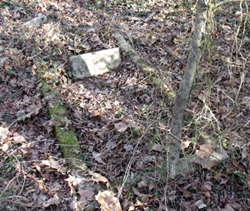
A couple of weeks ago, Dave Campbell, one of the regular volunteers did a little exploring. He came across an area with a bunch of graves, an area we hadn't known about. Then on Saturday, February 12, after finishing our work day at the cemetery, he and I decided to explore the area he had come across.
We got to the area and found lots of graves, many with gravestones. I went back to my truck to get my hand-held GPS unit so I could record the location. While I was doing that, Dave, started poking around and noticed that several of the gravestones showed a death date of 1941, the year that Pearl Williams died.

In a little bit, he found her grave. Fortunately, it did not have much overgrowth on it, so he could easily read the gravestone. When I got back, I thought that it sure seemed to be her grave, but I couldn't remember her exact death date so I had to wait until I got home to check her obituary. The dates matched. Her grave had been located.
I have GPS coordinates, so it shouldn't get lost again.
Mr. Williams is planning to come out to Evergreen next Saturday to see her grave. His family will probably come with him. It just so happen that a busload of VCU student volunteers was already scheduled to come out and work that day. Right now it takes some heavy bushwhacking to get to her grave. I plan to use the student volunteers to clear a path to her grave from the main road so Mr. Williams can easily get to the grave.
>Back to Top<
Order Your Limited Edition Color Prints of Historic Henrico Landmarks
Artist Henry Kidd has created two full-color drawings of Dabbs House (Robert E Lee's Headquarters in June 1862) and Walkerton Tavern (Circa 1825). These are the first in a series of full-color drawings depicting historical homes and buildings in Henrico County, Virginia. Prints of this limited edition are available in two sizes: 8.5" x 11" is $20 and 17" x 13" is $50.
Order your full-color drawings of Dabbs House and Walkerton Tavern from
Henrico County Historical Society
PO Box 90775
Henrico, VA 23273-0075
Make checks payable to Henrico County Historical Society. Virginia residents, please add 5% sales tax. Order Form
>Back to Top<
The HCHS 2011 Calendar
The calendar is more than just dates. It's 400 years of history. Order yours to keep.
All proceeds from calendar sales will go to fund a scholarship for a Henrico County student interested in the study of history.
Total cost for a calendar is $17.60. This includes $12.00 for the calendar; 60 cents for the tax; and $5.00 for postage/handling.
To place your order, contact Sarah Pace at 839-2407.
>Back to Top<
I Think I Shall Never See...
Here's a project that would make Joyce Kilmer happy.

Henrico County has been growing for 400 years, and we believe there may be some trees that have been growing almost as long, if not longer. We're looking for the oldest tree in the county. And while we're at it, we're also looking for other trees of historical significance. The majestic oak at the left is in a fenced area south of Hungary Spring Road across from the county office complex. Please let us know about any really old, beutiful, or historically significant trees in the county. Contact Joey Boehling at jboehling@verizon.net or Sarah Pace at sarah.pace@verizon.net.
>Back to Top<
Duty Officer Recalls 'Hank's' Last Days
We recently heard from David Bellak, a former crewmember of the USS Henrico. Here are his recollections:
Dear Friends:
Quite by chance I came across your website today, with its mention of the USS Henrico, and the final reunion of the Association last year.

As a matter of record, I was the duty officer on that day of decommissioning at Bremerton, WA in February 1968, and who signed the last and final logbook entry. I've sometimes ruminated that somewhere, in a dank and distant storage facility is that logbook. Herein lies a record of that closing ceremony with Capt Perez and assorted brass making their speeches, and my attempts at maintaining tradition with the final poem. Through the years I've occasionally seen the ship mentioned as the 'Hank" quietly rusted away in the mothball fleet.
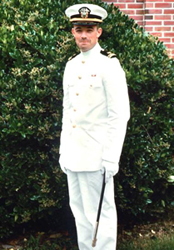
I joined the Henrico as a junior officer in October 1966 as its legal officer fresh from Newport RI law training facility. On board I served under Lt. Bob Owen as First Division officer. In this job I worked with 33 men overseen by First Class PO Jones, a most outstanding, professional bosn's mate. We worked so well together as a team. Jones was a fine man in every sense and an outstanding seaman. As he made clear early on, "Sir, I'll deal with the deck. You get on with your papers, and if I need your help, I'll ask you, Sir." And that was indeed the way it was. We knew that we could rely upon each other 110%.
There are many comments and reflections I could make about the Hank, and working aboard her. She was not an easy mistress, worn and tattered at the hems. Not much of her gear worked any more - radar, armaments, engine room, gyro repeaters, you name it. It took weeks to sail from the Phillipines to San Diego because one or the other of her engines would pack up, so it was 6 knots all the way across the Pacific.
Home for me has been in Edinburgh, Scotland for the past 29 years, so the Hank, and Virginia are a long way away. However, I join in saluting my former collegues and shipmates in seeing the Hank conclude her proud service.
With kind regards,
David Bellak
Lt/USNR
Edinburgh Scotland
>Back to Top<
A New Member Writes from Waynesboro
I recently discovered, qutie by accident, that I am a direct descendant of the original John Pleasants, who came from England to Henrico around 1655. My mother was a Pleasants, and I was able to trace her father Carl back 6 or 7 generations, straight back to John! Needless to say, this knowledge has had a profound effect on my life. I therefore wish to help support the HCHS in their endeavors!
Kay Conner Roetto
>Back to Top<
Forty Foot High (And Rising'?)
Flood levels of the Great Fresh of 1771 still stand as a record...
Sources:
Williams and Mary Quarterly, vol 5, 1897.
Dupigny-Giroux, Lesley-Ann and Gary J. Mock, eds. Historical Climate Variability and Impacts in North America.
Virginia Gazette, May 30, 1771.
Tyler's Quarterly Historical and Genealogical Magazine, vol 2, no 4, April 1921.
Photo from http://www.dhr.virginia.gov/registers/Counties/Henrico/043-0023_FloodMarker_VLR_4th_edition.jpg
At the intersection of New Market Road (Route 5) and Curles Neck Road, you will find a series of historical markers. One reads as follows:
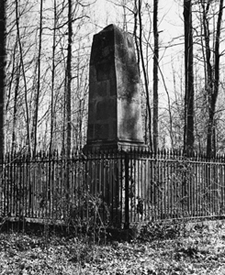
On May, 27, 1771, a wall of water came roaring down the James River valley following ten to twelve days of intensive rain. As water swept through Richmond, buildings, boats, animals and vegetation were lost. About one hundred fifty people were killed as the river reached a flood state of forty-five feet above normal. A monument to the flood was inscribed by Ryland Randolph, of Curles, in 1771-71:
"...all the great rivers of this country were swept by inundations never before experienced which changed the face of nature and left traces of violence that will remain for ages."
The marker recalls the events of the Great Fresh of 1771, the biggest flood to affect the James River valley in our recorded history. The marker suggests a flood stage of 45 feet. The level upriver at Richmond was 40 feet above normal, a level not even approached by the flood caused by Hurricane Camile in 1972. That "fresh" reached a level of 36.5 feet above normal at Richmond.
The marker also refers to the eighteen-foot-tall obelisk on a six-foot square base, constructed of brick and faced with cement. The eighteenth century monument at Turkey Island purportedly marks the high-water mark of the flood.
Contemporary accounts confirm that it was quite a flood. A letter to the Virginia Gazette of May 30, 1771, said:
There is now the greatest Fresh in James River even known, it being at least twenty Feet higher than that in May 1766. The Warehouses at Westham are entirely gone, with three Hundred Hogsheads of Tobacco. At Byrd's Warehouses, the Water is now Half Way up the Lower Tier of Hogheads; the other Warehouses of Shocko are almost under Water, and the Tobacco drifting away by thirty and forty Hogheads at a Time. It is imagined there might have been about three Thousand Hogsheads in the different Warehouses at Shocko. Almost every Lamber House is gone, and destroyed, on each Side of the River, many of them full of Good.
The magazine account continues:
Some People who left Richmond the same Day, in the Afternoon, say that the River was then rising at the Rate of two Inches an Hour, but we since learn, that it began to abate about Sunset.
All the low Ground have been overflowed, by which inconceivable Damage has been done. Every Thing was carried off to Farrar's Island, belonging to Colonel Thomas Mann Randolph, and at Elk Island, John Wayles, Esquire, is said to have suffered to the Amount of four thousand Pounds. Nothing being saved but the People and five Horses...
The Ships in the River were in most imminent Danger, from the vast Number of huge Trees driving down the Rapidity of the Current, and many of them have sustained great Damage. The Ships at Shirley Hundred were driven from their Mooring over to City Point, and those at City Point down as low as Jordan's.
The estimate was a bit off, and the river was really rising on May 26 at a rate of 19 inches per hour. On June 6, 1771, John Howard of Botetourt wrote to Dr. William Cabell in Amherst:
I received last night by my Fellow Cato accounts of the dismal Destruction made in James River by the late Fresh, in which I share very deeply, and I understand all my Crop of Tobacco that was growing is ruined as well as all that was in the Tobacco Houses about 6 Hogsheads, together with all my Tobacco Houses except one, are swept away, and 13 Hogsheads that were sent to the Warehouse, or Westham, I suppose are gone, as I hear the water was over both places, my Corn House with the Corn swept away, & some of my stock, and it is owing to the great goodness of God that my People are all alive.
On August 1, 1771, Richard Bland wrote to Thomas Adams:
Upon the 27th of May a most dreadful Inundation happened in James, Rappahannock and Roanoke Rivers occasioned by very heavy and incessant Rains upon the mountains for ten or twelve days...Promiscous Heaps of Houses, Trees, Men, Horses, Cattle, Sheep, Hogs, Merchandise, Corn, Tobacco & every other Thing that was unfortunately within the dreadful sweep were see [sic] Floating upon the Waters, without a possibility of their being saved.
Obviously, the flood was devastating, and it prompted the Assembly to issue 30,000 pounds in Treasurer notes for the tobacco lost at public warehouses.
>Back to Top<
Now You Know
With the aid of a pitter, you could make life a "Bowl of Cherries" or you could at least prepare a bowl of cherries.
Congratulations to Ron Axselle, who correctly identified the item pictured in the last "What Do You Know?" as a cherry pitter.
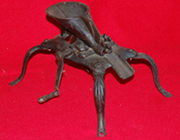
This pitter would remove the seeds from two cherries at a time. Fruit was put into the funnel-shaped opening, and the operator turned the crank. This caused the ribbed wheel in the center to force the cherries into the funnel, and as they were pushed into the narrowing channel, the pit was squeezed out and fell through the bottom. Thew newly-pitted cherries then rolled down the spout at the front and fell into a bowl.
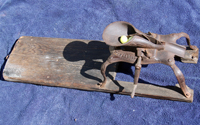
This photo shows a pitter of the same sort and bears a patent date of May 15, 1866. It operated in the same way, but was probably much more convenient. The operator sat on the board with the iron pitter hanging off the end of a bench to keep the pitter steady. Pits fell to the ground, and cherries were collected in a container placed near the spout. Wing-nuts at each side allowed for the adjustment of the width of funnel to accommodate larger or smaller cherries.
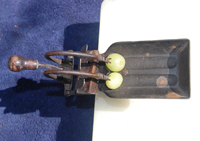
This pitter is about six inches wide and, like the others, will pit two cherries at a time. Cherries rolled down the grooved tray and came to a rest in two small holes. The operator then pushed the handle foward, forcing the pronged armed into the cherries and forcing the pits through the holes. The prongs also held the cherries while the arms were drawn back through the slotted plate, which knocked the cherries off the arms. They then rolled down the groove in the wooden ramp beneath the plate, and into a bowl that collected them.
Mary Randolph's 1838 The Virginia Housewife contained several recipes for cherries, which are below. You will notice that Mrs. Randolph didn't have the luxury of such a pitter, having to employ a quill instead!
Morello Cherries
Take out the stones with a quill over a deep dish, to save the juice that runs from them; put to the juice a pound of sugar for each pound of cherries, weighted after they are stoned; boil and skim the syrup, then put in the fruit, and stew till quite clear.
To Dry Cherries
Stone them, and save the juice; weigh the cherries, and allow one pound of good brown sugar to three of the fruit; boil it with the juice, put the cherries in, stew them fifteen or twenty minutes, take them out, drain off the syrup, and lay the cherries in dishes to dry in the sun; keep the syrup to pour over a little at a time, as it dries on the cherries, which must be frequently turned over; when all the syrup is used, put the cherries away in pots, sprinkling a little powdered leaf sugar between the layers. They make excellent pies, puddings, and charlottes.
Cherry Pudding
Beat six eggs very light, and add half a pint of milk, six ounces flour, eight ounces grated bread, twelve ounces suet, chopped fine, a little salt; when it is beat well, mix in eighteen ounces preserved cherries or damsins; bake or boil it. Make a sauce of melted butter, sugar and wine.
>Back to Top<
What Do You Know?
Here are two views of the same wooden object.
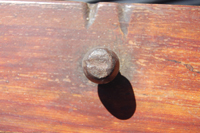
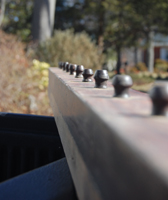
One shows a small section of the object seen along its length in the other picture. It is about four inches wide, and you can figure out how long it is from the picture. The two worn grooves in the top picture may provide a clue to its use.
Do you know what it is? Email your answers to jboehling@verizon.net.
>Back to Top<
News 2011: First Quarter
Second Quarter | Third Quarter | Fourth Quarter
Home | Henrico | Maps | Genealogy | Preservation | Membership | Shopping | HCHS
|











